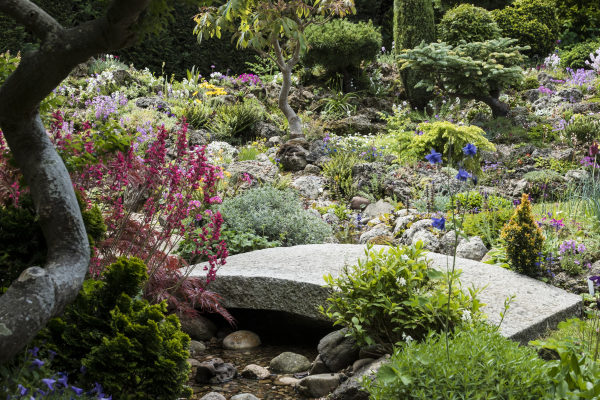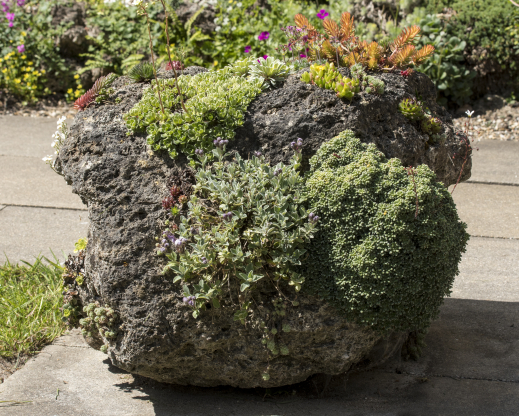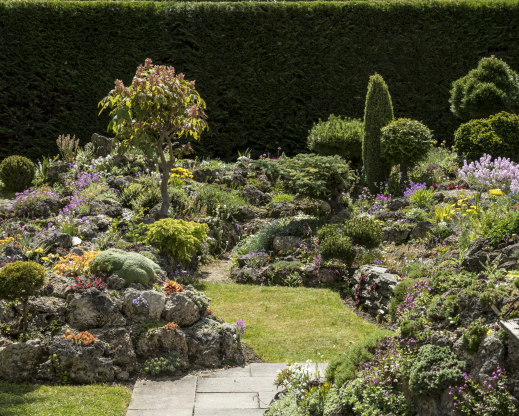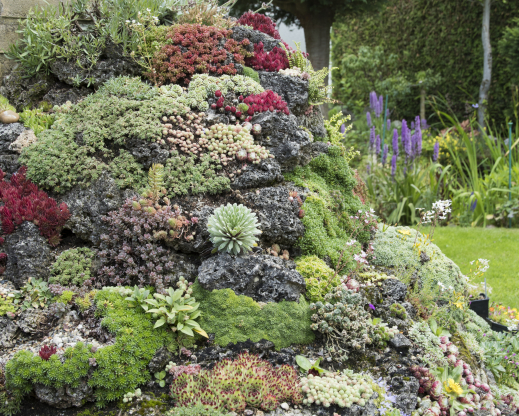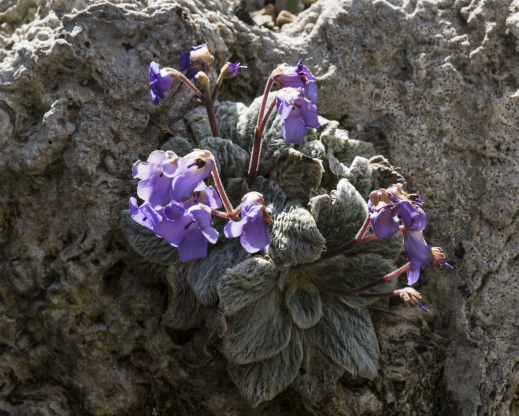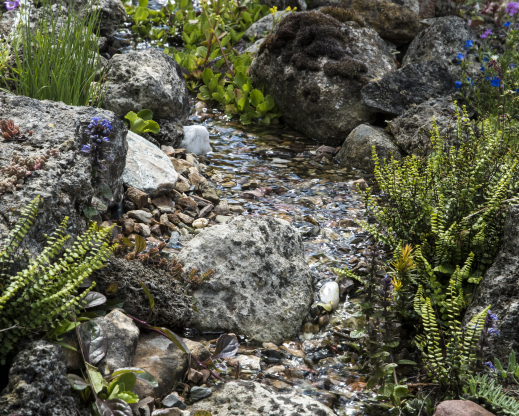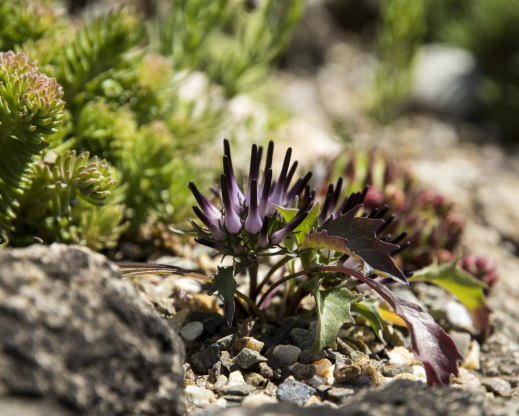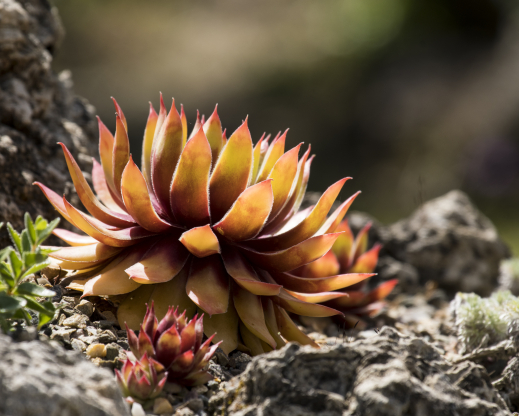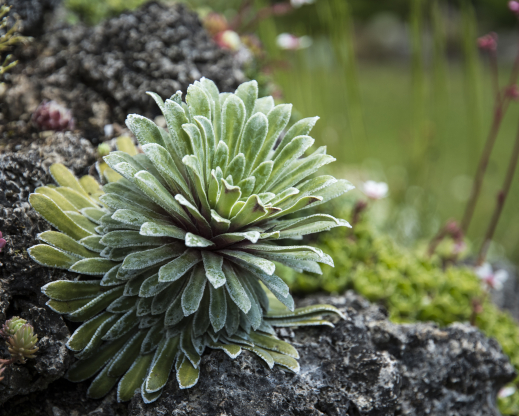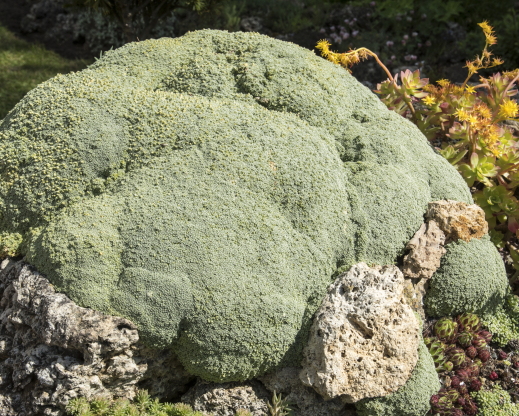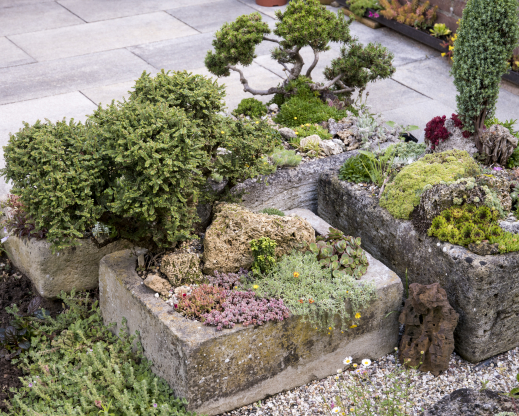As a child, Shirley Bijholt learned to love gardening from her father, who was also a plant lover. Her father collected orchids and bromeliads and the baskets and fern roots on which he grew them spontaneously sprouted ferns. Those small plants fascinated her even more than the cultivated material. "I like everything that is small and lovely," she says.
When Shirley got her own garden, she focused on small plants in the form of alpines and everything that resembles them. It started with lewisias, a relatively new plant for Dutch gardens some 30 years ago. She saw them in her father's plant book and immediately fell in love. Shirley became a member of the Dutch Rock Plants Association and came into contact with other enthusiasts and growers. On the advice of experts, she bought tuff (light-weight stone formed from volcanic ash), because rock garden plants would grow well on and in it. In 1995, Shirley moved to a house down the same street but with a larger garden. Everything from the old garden came along. "When you move, you take your stamp collection with you. So I brought my stones and plants along with me.”
Rock Islands
Shirley’s garden, with a modest area of just 2,000 square feet (90 m2), is full of tranquillity and space. If you have a rock garden and you can create such an atmosphere then you have done well. The construction and aesthetics of collectors' gardens are often subordinated to the plants. In other words, the plants come first and landscape design second. In Shirley's garden, plants and landscaping are equal and she marries them in a perfect way by not filling the entire surface of the garden with hills and rocks, but first making a lawn and a water feature in the shade of the house. On the terrace there are some beautiful troughs planted with dwarf shrubs, conifers, and various perennials including a beautiful group of Delosperma ‘Jewel of Desert Garnet’. On the other side of the terrace is a large planted piece of tuff with many Saxifraga, Sedum, Globularia, and Teucrium aroanium. In this way, the garden gains depth and you are more or less invited to walk into the garden to view the plants and the construction up close. The lawn continues for a while between a few rocky outcrops, creating rocky islands in the grass. Shirley got this idea in the 1990s from Czech gardens where rocks alternated with "grass plains," just as you might see in natural mountainous areas when a large rock protrudes from an alpine meadow. The big advantage of this construction is that paths are almost superfluous in these rocky outcrops. All maintenance can be done from the sides, sometimes with a step on a stone. On both sides of the garden is a path that forms a very natural transition to the rest of the garden. There is also a path at the back so that the roots of the hedge do not grow in the rock garden and the hedge can easily be cut without cluttering the garden with trimmings. That path is behind the elevation of the rock garden and you don't see any of it. The hard corner of the garage wall has been visually softened with a large boulder that looks like one large overgrown stone but in reality is made up of dozens of small pieces of tuff. From a spot next to this boulder, Shirley likes to take a close look at the rock garden. "This is my favorite spot in the garden. When I sit in my chair here in the morning, I can really enjoy all the plants on and in the rock garden."
Moving Water
A fast-flowing or gently babbling brook in the mountains makes your holiday an unforgettable experience. Everyone wants to take that image and bring it into the garden. That’s what Shirley did. A very quiet babbling brook, barely audible and sometimes barely visible, gives the garden an extra dimension. "I don't want the neighbors to be bothered by a loud gurgling brook and that's why just enough water flows through to make it cozy for us." The brook also offers possibilities for plants that like to be a bit wetter or benefit from the higher humidity. Asplenium trichomanes does appreciate the high humidity. Ajuga reptans has also found a suitable place here and the little-cultivated Chiastophyllum (syn. Umbilicus) oppositifolium also feels more at home by the water than in the dry parts of the rock garden. There is another subtle detail in the brook. No tuff stones are used there, instead, it is made with rounded stones as you see in real life in a stream or on the banks of a river. By the pond grows the spotted orchid, Dactylorhiza maculata. It is wonderful to have this wild plant that you see all along the roads in the Alps growing in the garden. It used to be rare in the Netherlands but now grows again in many places in nature reserves. Shirley has made the right habitat for this orchid, to the point of it almost becoming a weed: "He sows himself everywhere in the rock garden. Just look, there are also a few over there. I've already pulled a lot out."
Plant Gems
During a tour of Shirley’s garden, you’ll see such beautiful, special plants that you’ll almost be drooling. When I arrived, Jancaea (syn. Ramonda) heldreichii was just over the top. It is a strain found only on Mount Olympus in Greece and is known to be difficult to grow.
Physoplexis comosa was thick with flower buds. It is a plant from the Dolomites and the mountains north of Lake Garda. It is not too difficult to grow, though it is always eaten by snails in my own garden. Houseleek varieties are easy plants, but Sempervivum 'Gold Nugget' is surely an eye-catcher. Saxifaga longifolia also looks great. Unfortunately, it dies after flowering, so the longer it takes to start budding, the longer you can enjoy the plant. Erodium x variabile 'Bishop's Form' and Erinus alpinus are easy plants, but they flower very richly and if they become too much, you just pull a few out. Aubrieta is a massively cultivated spring flower that many people turn their noses up at, but Aubrieta 'Elsa Lancaster', with its intense flower color and scalloped leaves, is not to be sneezed at. Shirley finds Asperula sintenisii very beautiful and is very careful with her Arenaria tetraquetra, a gray-colored cushion plant with white flowers that is just as beautiful out of bloom. Saxifrages are very easy, but she doesn't like them very much when it comes to flowers. They are really foliage plants, forming beautiful rosettes and cushions.
Shirley tries to propagate everything herself, both by sowing seed and taking cuttings. She succeeds with many plants, but surprisingly, she failed with Degenia velebitica. Her sowing in pots and in the garden did not produce any plants. But persistence wins and the time will come when the yellow flowers of Degenia will be visible in the garden.
Chestnut and Conifers
In a rock garden, however small, it is okay to have some trees as long as they do not get too big. In Shirley’s garden a beautiful Aesculus pavia 'Koehnei', also known as dwarf horse chestnut, has a prominent place on one of the rocky hills and there are also several dwarf conifers, some of which Shirley bought in the Czech Republic in the last century. Pruning them regularly in such a way that they retain their natural shape will keep them small and allow them to be a beautiful part of the garden for years to come.
At the natural stone bridge over the stream is a red Japanese maple and in the troughs is a fine specimen of Ulmus parvifolia ‘Hokkaido’, a Juniperus communis ‘Compressa’, and an almost bonsai-like Pinus mugo ‘Mops’. Keeping these trees and shrubs small and in shape requires pruning. Eventually, though, there can come a time when a conifer or shrub really gets too big and can no longer be pruned in such a way that it seems natural. Then you have to say goodbye to that plant, but that is often a matter of deliberation because removing a tree changes the garden dramatically.
Tools
You can't do much in a rock garden with a regular spade and a hoe. Shirley's husband Joost has made appropriate tools and she now literally gardens with a knife and fork. Joost bent the teeth of a fork to form a mini rake. She finds the overblown flowers of the abundantly blooming carnations unattractive, so she cuts them off with mini sheep scissors or kitchen scissors. Her main tool is a modified apple corer which she uses to make planting holes between the stones and uproot weeds. A pair of mini scoops, an old grout nail, a vegetable peeler, and tweezers complete the set. It is hilarious to see this tool set and realize that most of the gardening work is done with them. Gardening on this small scale is relaxing and enjoyable for Shirley and it is proof that even the smallest space can be turned into a paradise in which you can spend almost all year round with plants.

